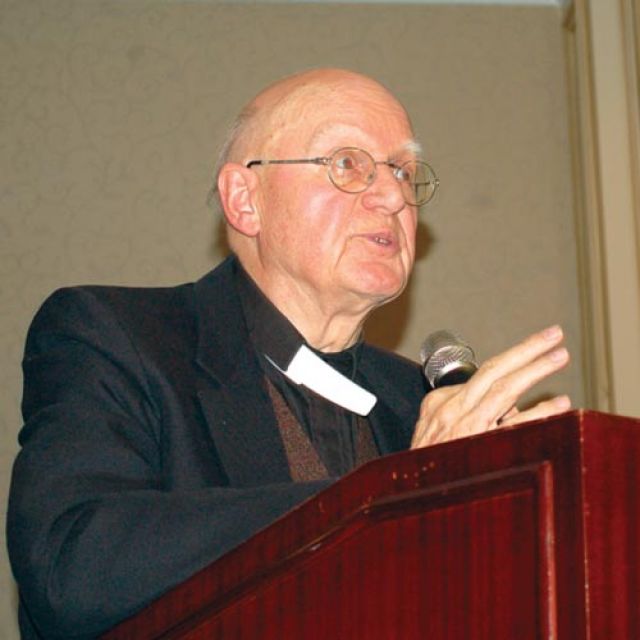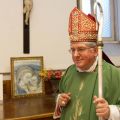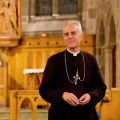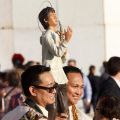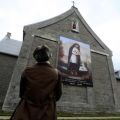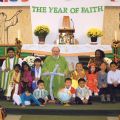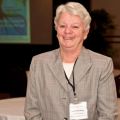NEWS
TORONTO - About 300 people from the pro-life community filled a banquet hall at Spirale Restaurant Oct. 18 to honour Fr. Alphonse de Valk, the recently retired editor of Catholic Insight magazine.
“He was ahead of his time with his warning of legalizing abortion,” said Steve Jalsevac, managing director of LifeSiteNews. “In all the years I’ve known Fr. de Valk he’s been faithful, faithful, faithful.”
Jalsevac first got to know de Valk in 1984 when the Basilian priest moved to Toronto from the Prairies, where his pro-life journalism began shortly after penning Morality and Law in Canadian Politics: The Abortion Controversy. Both members of Campaign Life Coalition, which de Valk joined in 1978 while principal of St. Joseph’s College at the University of Edmonton, the two were always able to look past their personal differences in the name of life.
“Both being Dutchmen, actually I’m only half Dutch, we’ve had our differences,” said Jalsevac at The Testimonial Dinner for Fr. Alphonse de Valk, which was sponsored by a number of pro-life organizations. “But I prefer a man who isn’t lukewarm.”
As a post-secondary educator in both Saskatoon and Edmonton during 1970s and early ’80s, de Valk published more than 200 articles addressing abortion issues in papers which circulated on the campus. These writings helped to recruit young pro-life support.
While living in Edmonton de Valk had gathered enough supporters to begin publishing booklets, 12to 24-pages long, focusing on issues facing the pro-life movement. The group produced 36 editions over a 15-year period before de Valk moved eastward and joined Campaign Life Coalition fulltime.
“It was a wonderful thing to find a group of people whom we could associate with and who shared the value of human life, who shared the teachings of the Church,” said de Valk.
He also began writing for The Interim, a Toronto-based pro-life newspaper, that same year and eventually became editor, a position de Valk held from 1987 to 1992.
As a reporter, de Valk made the transition from advocate to activist when, in 1985, he was arrested for chaining himself to the Morgentaler Clinic’s gate. One night in the Don Jail was all de Valk served thanks to the province’s Attorney General withdrawing the charges after hearing a priest was imprisoned.
The arrest didn’t scare off de Valk who continued to be a regular, slightly less radical, picketer outside the clinic every Friday for almost five years — even after the 1989 injunction prohibiting such protests. Over these years he was arrested another eight times and fined $750 or two weeks in jail for trespassing — a fine he hasn’t paid, jail time he has not served.
“Fr. de Valk could always be counted on to state the blunt truth about controversial goings on,” Jalsevic wrote in the evening’s program.
De Valk continued to do just that after leaving The Interim with the launch of Catholic Insight in 1993.
Following a stroke, and his 80th birthday this March, de Valk decided that Catholic Insight’s publisher, the Board of Directors of Life Ethics Information Centre, should seek a new editor.
Although no longer a member of the editorial team, de Valk continues to sit on both the advisory and publishing boards of Catholic Insight.
“God’s grace has allowed us to withstand the sexual revolution,” de Valk said during the dinner’s closing speech.
“Whatever you do, work at it with your whole being. Do it for the Lord rather than for me since you know fully well that you will receive an inheritance from Him as your reward.”
Catholic Charities turns 100
By Evan Boudreau, The Catholic RegisterTORONTO - Catholic Charities of the Archdiocese of Toronto has begun celebrations of its 100th anniversary.
The organization functions as an umbrella charity for Catholic social service agencies in the province of Ontario. In it’s inaugural year the charitable organization funded eight agencies, a number that has since grown to 29 serving about 250,000 people.
“We make a real positive difference in the lives of people,” said Michael Fullan, Catholic Charities’ executive director for the past 19 years. “Often when there isn’t hope we help to re-instill that ... hope.”
These agencies include Providence Healthcare, Covenant House Toronto and Natural Family Planning Association. Among those who benefit from these agencies are impoverished youth, the elderly and those suffering from illness ranging from disabilities to substance abuse issues.
“Those most at risk of falling through the cracks of the service agencies is typically where the Catholic agencies have been responding,” said Fullan. “(They’re) the most vulnerable in society.”
Currently Catholic Charities injects about $8.5 million into the province’s social service network. While most of the money comes from ShareLife, Fullan said a lot of outside funding comes as a result of Catholic Charities’ contributions.
“Our funding is like a catalyst to attracting other funding,” he said. “Governments and other funders recognize the contributions that the Catholic agencies make.”
During his speech at the 33rd Annual Cardinal’s Dinner on Oct. 11, Toronto’s Cardinal Thomas Collins made a point of acknowledging the milestone year for the organization started a century ago by then Archbishop Neil McNeil.
“When it comes to helping others, whether it is those suffering from a natural disaster across the ocean, or those closer to home, faith-based organizations are the first in and last out,” said Collins, adding that centenary celebrations will culminate with a special Mass next September.
Collins praised both the agencies supported by Catholic Charities and parishioners whose donations make the agencies’ work possible.
But Catholic Charities is more than a money allocator.
“Catholic Charities historically had a direct contribution to the development of the present universal health care system in this country,” said Fullan. “That’s something that we should be very proud of.”
That kind of government lobbying continues today, although the area of attention has shifted. Catholic Charities is currently attempting to have the government address child poverty, affordable housing and social service funding.
“We’re trying on the systematic level to make changes that need to happen,” said Fullan. “We’re making some people expendable in our culture and there’s something very wrong with that.”
What the next 100 years will look like for Catholic Charities is unclear to Fullan. What he does know is that demands will change, as always, and Catholic Charities will respond, as always.
D&P’s French youth wing pulls out of fall campaign
By Michael Swan, The Catholic Register(UPDATED 25/10/12)
The French-speaking youth wing of the Canadian Catholic Organization for Development and Peace has withdrawn its support of the organization’s fall education campaign and next spring’s Share Lent drives in protest over a decision to first delay and then change this fall’s education campaign.
Development and Peace’s traditional fall campaign was to have included postcards addressed to Prime Minister Stephen Harper requesting a national consultation on the direction of foreign aid policy. CCCB president Archbishop Richard Smith and CCCB general secretary Msgr. Pat Powers informed Development and Peace’s leaders in September that several bishops were uncomfortable with the directly political tone of the campaign, leading Development and Peace to delay the launch for a month and withdraw the postcards.
“This decision by our leadership undermines the credibility of our movement and renders it impossible to recruit new members or to maintain engagement among our youth groups,” wrote nine francophone youth representatives who met in Montreal just before the fall education campaign launched Oct. 15.
In a “declaration” issued Oct. 16, the representatives claim the way in which the bishops maneuvered Development and Peace into compromising its plans caused them to question the prophetic role of the organization within the Church.
“We have cried and shared our suffering and anger,” they wrote.
The young members said they understood the gravity of withdrawing their support at this time but claimed something had to be done to force reform on the leadership. Instead of participating in the fall campaign the youth wing will launch an internal campaign to return Development and Peace to its democratic roots and original mission.
Attracting new members, especially among youth, is one focus of this fall’s campaign.
“We knew there would be some members who would be very frustrated with this. That’s not a surprise,” said Development and Peace national council president Ronald Breau.
The national council is looking forward to speaking with youth representatives about their concerns, Breau said. Ariane Collin, who represents francophone youth on the national council, will be able to present her concerns at a full national council meeting scheduled for Nov. 30 to Dec. 2. Internal dissension is a normal part of life in Development and Peace, said Breau.
“I don’t think we’re seeing the disintegration of the movement,” he said. Some of the most vocal criticism of CCCB interference in the organization’s affairs has come from Quebec and francophone New Brunswick, but Breau said he doesn’t believe the Catholic movement set up by Canada’s bishops in 1967 is splitting along linguistic lines.
“I don’t see a French-English split. I see that the French members have a real passion, they have a real strong foundation and they really, really believe — and they’re more expressive,” Breau said.
“That’s good for the movement.”
The bishops are not worried about a gulf between English and French opinion on the development agency, said CCCB spokesman Rene Laprise.
"Half of the members of the CCCB standing committee (on Development and Peace) are francophones, as are half the members of the CCODP liaison committee, and our experience with both committees has shown no divisions along linguistic lines," Laprise wrote in an email.
The CCCB has backed the "Do It Justice" fall campaign by announcing the launch and posting a link to the Development and Peace site on it's own web site. A four-page background paper on international development policy got the thumbs up with only minor changes from the CCCB’s committee on Development and Peace and from Development and Peace’s liaison committee for relations with the bishops. The campaign materials also include a video introduction viewable on YouTube. Other campaign materials are available at www.devp.org .
Toronto cardinal 'becoming a parish priest' as honorary pastor in Rome
By Francis X. Rocca, Catholic News ServiceROME - Cardinal Thomas Collins of Toronto took possession of his titular church Oct. 23, celebrating an evening Mass at St. Patrick's Church in Rome.
"Now, after 40 years of ordination to the priesthood, I am, in a certain sense, becoming a parish priest," the cardinal said in his homily.
Cardinal Collins, who became a cardinal in February, was assigned to be honorary pastor of the Irish national church in Rome, which is entrusted to the Augustinian order. All cardinals are given honorary title to a church in Rome, as a reminder that the early popes were elected by the city's pastors.
"Although a cardinal relates to the universal church, he is also a parish priest, and that's something very, very beautiful," the cardinal told the congregation, which included pilgrims from Toronto and his former Archdiocese of Edmonton, Alberta, as well as Anne Leahy, Canada's ambassador to the Vatican.
"The church is universal and the church is always local, like concave and convex, the universal and local," he said. "Those two must go together."
The cardinal concelebrated with about 20 priests, including Archbishops Gerald Lacroix of Quebec, Gerard Pettipas of Grouard-McLennan, Alberta, and Richard Smith of Edmonton, president of the Canadian Conference of Catholic Bishops; and Bishop Lionel Gendron of Saint-Jean-Longueuil, Quebec.
"As Christians, we need to be solid as a community of faith in building the temple of the Lord," the cardinal said. "But it's not enough to be stable, solid, joined together. If we were only to do that, we would miss the point of who we are."
"We need to have that fire, that zeal for evangelization," he said, pointing to the example of St. Patrick, the apostle of Ireland. "We are called to spread that life, that light, that fire, and kindle fire in the hearts of others."
SSPX expels Bishop Williamson, who opposed talks with Vatican
By Cindy Wooden, Catholic News ServiceVATICAN CITY - The leadership of the traditionalist Society of St. Pius X has expelled British Bishop Richard Williamson from the society, saying he distanced himself from them and refused "to show due respect and obedience to his lawful superiors."
"This painful decision has become necessary by concern for the common good of the Society of St. Pius X and its good government," said a brief note posted on the group's web site Oct. 24.
Williamson had been a harsh critic of the group's engagement in doctrinal discussions with the Vatican, which were aimed at bringing the society back into full communion with the Catholic Church.
In comments published Sept. 1 in a newsletter that Williamson e-mails to subscribers, he wrote that the SSPX had set out six conditions for reconciliation with Rome, which included: freedom "to teach the unchanging truth of Catholic tradition"; freedom to criticize "the errors" of the Second Vatican Council; freedom to celebrate only the extraordinary form of the Mass; the promise of at least one new bishop; and the independence of SSPX houses from the oversight of the local diocesan bishop.
In the September letter, Williamson said, the SSPX position was "no longer 'Rome must convert because truth is absolute,' but now merely 'the SSPX demands freedom for itself to tell the truth.' Instead of attacking the (Vatican II) conciliar treachery, the SSPX now wants the traitors to give it permission to tell the truth?"
The bishop concluded, "Unless the society's leadership is shaken out of its dream of peace with conciliar Rome ... then the last worldwide bastion of Catholic tradition risks being on its way to surrendering to the enemies of the faith."
The statement announcing the ouster of Williamson from the SSPX said the decision was made by the superior general, Bishop Bernard Fellay, and by members of the SSPX council. It said the SSPX leadership met Oct. 4 and gave Williamson a deadline of Oct. 23 "to declare his submission" to the SSPX leaders. Instead, the statement said, Williamson sent a letter resigning from the group.
Even as the Vatican negotiated with the SSPX, Vatican officials said separate discussions would be required with Williamson, who not only criticized the dialogue, but has publicly denied the extent of the Nazi Holocaust of the Jews.
The bishop's Holocaust denials were included in an interview aired by a Swedish TV network on the same day in 2009 that the Vatican announced Pope Benedict XVI had lifted the excommunication of Williamson and three other of the society's bishops, ordained without papal permission in 1988.The Pope later repudiated Williamson's remarks, saying he had been unaware of the bishop's views on the Holocaust. The Pope met with Jewish leaders at the time to calm tensions over the incident.
Additionally, the Vatican told Williamson that he would not be welcomed into full communion in the Church unless he disavowed his remarks about the Holocaust and publicly apologized.
After lifting the excommunications, Pope Benedict launched a new series of doctrinal discussions with the SSPX in 2009. As the discussions progressed, the Vatican asked SSPX leaders to sign a "doctrinal preamble,"' which outlines principles and criteria necessary to guarantee fidelity to the Church and its teaching.
When it appeared Fellay was close to signing an agreement with the Vatican, internal tensions within the SSPX erupted. Williamson was excluded from the July general chapter meeting of the SSPX "due to his stand calling to rebellion and for continually repeated disobedience," according to a letter leaked to the press. Without Williamson present, SSPX leaders recovered their "profound unity," according to a public statement released after the July meeting.
In an early October interview with a German radio station, Archbishop Gerhard Muller, prefect of the Congregation for the Doctrine of the Faith, confirmed that the talks with the SSPX had broken down and that no further discussions had been scheduled.
Pope names six new cardinals
By Cindy Wooden, Catholic News ServiceVATICAN CITY - Pope Benedict XVI surprised pilgrims in St. Peter's Square Oct. 24 by announcing he would create six new cardinals in late November.
The Pope said the consistory to create the new cardinals, who come from six countries, would take place Nov. 24, the feast of Christ the King.
It will be the smallest group of cardinals created since the 1977 consistory when Pope Benedict, the then-Archbishop Joseph Ratzinger, received his red hat from Pope Paul VI along with three other churchmen.
The new cardinals will include: 63-year-old U.S. Archbishop James Harvey, prefect of the papal household; Lebanon's Maronite Patriarch Bechara Rai, 72; Archbishop Baselios Cleemis Thottunkal, 53, head of the Syro-Malankara Catholic Church; Nigerian Archbishop John Olorunfemi Onaiyekan of Abuja, 68; Colombian Archbishop Ruben Salazar Gomez of Bogota, 70; and Philippine Archbishop Luis Tagle of Manila, 55.
Pope Benedict made the announcement at the end of his weekly general audience, which was attended by about 20,000 pilgrims. As is usual, Cardinal-designate Harvey was seated next to the Pope during the audience. While he did not visibly react when his name was announced, the new cardinal-designate smiled and had a brief moment with the Pope before returning to his normal duties of helping lead important guests up to the Pope.
Telling the crowd that he had the "great joy" of announcing new cardinals, Pope Benedict said cardinals have "the task of helping the successor of Peter in his ministry" of strengthening people's faith and promoting the unity of the Church.
The Pope asked Catholics to pray that the new cardinals would "always love Christ and His Church with courage and dedication."
Of the six soon-to-be cardinals, only Cardinal-designates Harvey and Salazar were not members of the world Synod of Bishops on the new evangelization, which was meeting at the Vatican when the Pope made his announcement.
The late-November consistory will bring the total number of cardinals to 211 and the number of cardinals under age 80 to 120. Until they reach their 80th birthdays, cardinals are eligible to vote in a conclave to elect a new pope.
Trial set for second Vatican employee; report issued on butler's trial
By Cindy Wooden and Carol Glatz, Catholic News ServiceVATICAN CITY (CNS) -- Claudio Sciarpelletti, the Vatican Secretariat of State computer technician accused of aiding and abetting the pope's butler in stealing confidential Vatican correspondence, will go on trial at the Vatican Nov. 5.
The Vatican announced the trial date Oct. 23. Jesuit Father Federico Lombardi, Vatican spokesman, told reporters that Sciarpelletti's trial on the "minor charges" of aiding and abetting was expected to be brief.
Also Oct. 23, the Vatican released a 15-page document from the three-judge panel that found the butler, Paolo Gabriele, guilty Oct. 6 and sentenced him to 18 months in jail.
After criminal trials in Italy and at the Vatican, the judges publish a detailed explanation of how they arrived at their verdict and how they determined the sentence. Father Lombardi said a Vatican prosecutor will study the document and has 40 days to decide whether he will file an appeal, something usually done to request a harsher sentence.
Gabriele, who also had a chance to appeal his conviction, declined to do so; he remains under house arrest until the prosecution decides about its appeal, Father Lombardi said. Pope Benedict XVI also could pardon his former butler.
Father Lombardi said that if the pope does not pardon the 46-year-old Gabriele, Vatican judicial officials plan to have him serve his sentence in a 12-foot-by-12-foot cell in the Vatican police barracks and not in an Italian prison.
The report included the fact that the judges denied a request by Gabriele's lawyer to have retired Cardinals Ivan Dias, former prefect of the Congregation for the Evangelization of Peoples, and Georges Cottier, former theologian of the papal household, testify before a papally appointed commission of cardinals conducting a separate investigation of the leaking of Vatican documents.
The judges said it was beyond their powers to do so; there was no explanation of what kind of information the defense thought the two cardinals could provide.
In the judges' report, they said that while Gabriele consistently maintained he acted out of love for the pope and the church, the judges felt an obligation "to observe how the action undertaken by Gabriele in reality was harmful" to "the pontiff, the laws of the Holy See, the whole Catholic Church and Vatican City State."
Much of the material simply summarized information collected during the initial investigation of Gabriele and the testimony given during his trial Sept. 29-Oct. 6.
But the judges' reactions to several points raised by Cristiana Arru, Gabriele's lawyer, were explained in detail, particularly regarding Arru's contention that since the material found in Gabriele's apartment consisted of photocopies, not originals, the former butler didn't actually steal anything.
First, the judges said testimony from Msgr. Georg Ganswein, the pope's personal secretary, and from Vatican police officers who searched Gabriele's Vatican apartment proved to them that a few originals were among the photocopies.
Second, they said, Gabriele removed the originals without permission in order to photocopy them, but even more, they said, while he might not have stolen many original documents, by photocopying them he took the information written on them without consent.
"The paper document is nothing other than the support material for an immaterial content," the judges said.
During the trial, Arru repeatedly raised questions about the Vatican prosecutor's assertion that police found in Gabriele's Vatican apartment three items given to Pope Benedict as gifts: a check for 100,000 euros ($123,000); a gold nugget from the director of a mining company in Peru; and a 16th-century edition of a translation of the "Aeneid."
The judges' explanation of their verdict basically said they made their judgment based on the theft of confidential papal and Vatican documents, not on the three gifts.
A separate area of the report concerned whether or not Gabriele was capable of understanding his actions, which the judges answered affirmatively.
The judges cited several statements made by Gabriele, both during the investigation and at the trial, to the effect that he knew what he was doing was wrong, he took extra precautions to avoid being caught and he went to confession when it became clear he was about to be arrested.
The judges also discussed the points that, in their view, made Gabriele's actions a case of "aggravated theft" and not simple theft.
The main aggravating factor, they said, was the fact that Gabriele abused his position of trust: "In effect, Gabriele was able to commit the crime he's accused of because of his work relationship with the Holy Father, which necessarily was based on a bond of trust."
Gabriele's job brought him into the very private life of Pope Benedict, and the butler violated the "absolute reserve" such a position required, the judges said.
"He used this unique position to perpetrate his criminal actions," they said.
While recognizing that Gabriele was not paid for leaking the documents to an Italian journalist (who, in turn, published them in an instantly best-selling book), the judges said he still committed the crime with the intent to profit from it "intellectually and morally."
The judges quoted him as telling investigators, "Even if the possession of those documents was illicit, I felt I had to do it for various reasons, including my own personal interests." Gabriele, they said, felt that having the documents would help him better understand the inner workings of the Vatican, and leaking them to a journalist would help him provide the "shock" that could lead to change in the Vatican, which he felt was becoming filled with corruption and careerism.
In the verdict, the judges ordered Gabriele to pay the Vatican's court costs, which Father Lombardi said amounted to the equivalent of about $1,300.
Pilgrims flock to Rome to celebrate their new saints
By Cindy Wooden, Catholic News ServiceVATICAN CITY (CNS) -- Wearing Native American beads and feathers, Hawaiian leis, classic Filipino shirts, or German dirndls, Catholics from around the globe gathered in St. Peter's Square to celebrate the recognition of seven new saints.
One of the pilgrims who came to celebrate the canonization of St. Kateri Tekakawita Oct. 21 was Blessed Sacrament Father Dana Pelotte, twin brother of the late Bishop Donald E. Pelotte of Gallup, N.M., the first American Indian bishop of the United States.
"I think the canonization will have a tremendous spiritual effect on the native peoples -- I really do. Being a native person has so much spiritual beauty," and the canonization of Kateri, the first indigenous saint of North America, will strengthen that, said the priest, whose father was of Abenaki descent.
Attending a reception sponsored by the U.S. Embassy to the Holy See in the Vatican Museums' garden Oct. 19, Father Pelotte was constantly approached by American Indian pilgrims who told him of their love for his brother and how pleased he would be by the canonization. "I know he's here in spirit with us today," Father Pelotte told each one of them.
Archbishop Charles J. Chaput of Philadelphia, a member of the Prairie Band Potawatomi Tribe, told Catholic News Service that he and his fellow Native American Catholics have been praying for St. Kateri's canonization for a very long time.
The saint was born to an Algonquin Christian mother and a Mohawk father, who died when she was young. She resisted strong pressure from the Mohawks to abandon her faith, so she could be considered a model for those facing religious persecution, the archbishop said.
St. Kateri, who died in 1680 at the age of 24, also is a model for the new evangelization, Archbishop Chaput said.
"She was a young, vibrant member of her community, but she was different from the rest of them because of her unique personal relationship with Jesus Christ, which is what sanctity is generally about -- it's about taking Christ seriously in a personal way, in a way that goes beyond where most of us go."
Clarence "Boogie" Kahilihwa and Gloria Marks were two of nine patient-residents who came to the canonization from Kalaupapa, Hawaii, where the new St. Marianne Cope ministered among people with Hansen's disease, which is commonly called leprosy.
Kahilihwa said St. Marianne left as her legacy "how she felt toward humanity," and that her message is "never underestimate" the value of person, no matter what their sickness is; "and don't be afraid to challenge the unchallenged and down low."
"I could have gone out a long time ago, but I chose to stay" to help care for older members of the community, he said.
Kahilihwa also said part of St. Marianne's legacy is the affirmation that there is no such thing as "a leper," because leprosy "is a disease, not a person."
Marks, like Kahilihwa, came to Rome in 2009 for the canonization of St. Damien de Veuster of Molokai, who founded the Kalaupapa community and who later was among those cared for by St. Marianne.
"I'm really proud because (there are) two of them from the same county, the smallest county in Hawaii," she said.
"Those two put Hawaii on the map. So it's very, very important to us."
U.S. citizens and residents also turned out in large numbers for the canonization of St. Pedro Calungsod, a Philippine teenager and catechist who was martyred in 1672 in Guam, which is a territory of the United States.
At a thanksgiving Mass Oct. 22 at the Altar of the Chair in St. Peter's Basilica, Archbishop Anthony Sablan Apuron of Agana, Guam, called St. Pedro a wonderful model for Catholic youth. "May it never be said that we who had the privilege of witnessing the canonization of San Pedro did not make it heaven!" he told the pilgrims, who included many young people.
The archbishop, who concelebrated the Mass with retired Cardinal Ricardo Vidal of Cebu, Philippines, composed a song in honor of St. Pedro 12 years ago on the occasion of the youth's beatification. Archbishop Apuron sang it during the homily, demonstrating that he, too, saw the martyred saint as a model.
"San Pedro proclaimed his faith using human means to attract the Chamorros (native people of Guam) through the use of visual aids, putting the doctrines and teachings to music so as to enable the natives to learn the doctrines of the church more easily," Archbishop Apuron said.
Discalced Augustinian Father Alex Remolino, a Philippine priest working in Rome, said that in addition to being a model for youth, "St. Pedro is a patron saint of our emigrants."
St. Pedro left the Philippines to work with the Jesuits in Guam, and he carried his faith with him, just as many Philippine emigrants do today when they go abroad to study or work, he said.
"Faith is part of our DNA," Father Remolino said. "Wherever we go, we bring the Gospel. It's not just part of our culture, but part of our character."
- - -
Contributing to this story were Carol Glatz and Francis X. Rocca.
Canadians see St. Kateri's canonization as help for reconciliation
By Cindy Wooden, Catholic News ServiceVATICAN CITY - After decades of resentment and horror over the abuse of indigenous children, the canonization of St. Kateri Tekakwitha marked a further step toward the reconciliation of the indigenous communities and the Catholic Church.
Phil Fontaine, former national chief of the Assembly of First Nations of Canada, told Canadian church and government officials the canonization "makes it possible, very much possible, to bring our community -- the First Nations -- very much closer with the Catholic Church. There was a rupture for too long."
Fontaine headed a 2009 Canadian aboriginal delegation to the Vatican, which received a formal apology from the church for the treatment of native children in Canadian residential schools.
An estimated 100,000 aboriginal children passed through the schools, which were abolished in the 1990s. They were established and paid for by the Canadian government, but were administered by various church organizations, including Roman Catholic dioceses and religious orders. The schools became known for widespread physical and sexual abuse of children and have been blamed for contributing to the disappearance of native languages and cultures.
Fontaine spoke at a reception after the canonization and Mass Oct. 21, addressing Canadian bishops, other First Nations leaders and a government delegation led by Andrew Scheer, speaker of the House of Commons.
Anne Leahy, Canadian ambassador to the Holy See, said the government delegation was a sign of just how much importance the government gave the canonization of St. Kateri, the first aboriginal saint from North America.
When Fontaine led the native delegation to the Vatican in 2009, he said, "we were blessed with a private audience with His Holiness (Pope Benedict XVI)," who gave the First Nations "great comfort. And now, here we are, three years later and we have another blessing: being witness to another very significant event," the official recognition of St. Kateri.
Her canonization, he said, "makes it possible to share our daughter with the universal church."
"If you link the two events" -- the 2009 meeting and the canonization -- "it is all about imparting reconciliation," Fontaine said.
The canonization, he said, "is an opportunity for us to say, 'We accept your apology, we forgive, and so now let us begin taking the important steps of healing and reconciliation."
Sylvain Chicoine, a member of the Canadian Parliament representing Chateauguay-Saint-Constant, Quebec, which includes the mission where Kateri died in 1680, told Catholic News Service the canonization is especially important in his region.
"They used to tell stories of Kateri in our schools, until about 30 years ago," he said. "Now the young will know her, too."
"Kateri made a bridge between the Europeans and the First Nations, and she can be an example today to rebuild bridges between our communities," which are still experiencing lingering tensions over land-use disputes from the 1990s, Chicoine said. "There is still work to do in repairing the relationship."
Elaine Johnson, a nurse and member of the Peter Ballantyne Cree Nation in northeastern Saskatchewan, said she came to Rome for the celebration because St. Kateri "is our first First Nations saint. We need to empower ourselves and she's our role model for being prayerful, humble and giving. As a First Nations person, I just wanted to be present."
"We as First Nations people would not look at her as having adopted European culture. Christianity does not take away our identity," she said. "I was born and raised a First Nations person and a Catholic, which empowers you because your ultimate goal is heaven. The church strengthens you."
Tobasonakwut Kinew, an Ojibway elder and university lecturer, came from Winnipeg for the canonization. A survivor of abuse at a residential school, he was part of the First Nations delegation that met the pope in 2009.
He told CNS, "I was sitting in a hotel in Thunder Bay (Ontario) in 1970 and was asking, praying, begging to be freed from alcohol and that's the last time I took a drink. I grew up praying to Kateri, and I used to think prayers were never answered, but here I am today."
Asked to write out his name for a reporter, Kinew did so, saying, "That's one thing I did learn at the residential school."
St. Wilfrid’s opens a diverse Year of Faith
By Evan Boudreau, The Catholic RegisterTORONTO - The Year of Faith kicked off Oct. 14 in a multicultural way for one of the most culturally diverse parishes in a city known for its cultural diversity.
At the noon Mass, St. Wilfrid’s Church in northwest Toronto joined other parishes across the archdiocese in kicking off the Year of Faith, but in a way that reflects the face of its parishioners.
“The Year of Faith was inspiration the Church received to reflect on our faith but also on our diversity,” Fr. Massey Lombardi told those gathered.
“There’s about 45 different languages in this parish but I would think if you went to other parishes in the city you would find the same thing.”
To celebrate the cultural melting pot that is his parish and city, Lombardi hung about 40 miniature flags on the walls surrounding the altar. These flags represent the heritage of the parishioners who attend his services weekly. On this Sunday the church, brightened by the colourful attire worn by many, was filled beyond its 1,000-occupancy capacity with parishioners lining the back wall and spilling out into the foyer.
“Those flags are going to stay up all year and we are going to have programs that speak of the diversity,” said Lombardi. “This parish here is very diverse and we want to celebrate that. It’s really trying to build an understanding of cultures and respect.”
Fol lowing communion Lombardi invited parishioners to offer a sign of peace and recite the Our Father in their native language. After the service parishioners headed to the parish hall to sample lunch dishes as diverse as the cultural attire they donned, sharing their diversity as one community.
“It’s both a joining together and sharing food and there is nothing like joining together to share food,” said Lombardi.
Lombardi said plans are in the works to expand this all-encompasing atmosphere outside of the church’s walls.
On Oct. 21 the parish will dedicate a statue to St. Padre Pio.
“This is really a segue into all the other things we can do in terms of our liturgy, in terms of our practice, our programs, but also in terms of our outreach to the poor, sick and the marginalized in our community,” said Lombardi. “Faith is not faith in the vacuum, it’s promoted, it’s increased, it’s deepened through cultures.”
Real love, support key to battling abuse
By Michael Swan, The Catholic RegisterTORONTO - For most of her career as a leading pediatrician and professor of medicine, Sr. Nuala Kenny diagnosed cancers, complex infections and syndromes in some of the smallest, frailest and most precious bodies among us.
At 70, having survived her own cancer, Kenny has turned her diagnostic eye on the body of Christ itself.
In Healing the Church: Diagnosing and Treating The Clergy Sexual Abuse Crisis, Kenny examines the history, cause and symptoms of the greatest crisis the Church has faced in its modern history — sexual abuse of children and youth by priests, and bishops who protected and reassigned offending priests.
She doesn’t come at the subject out of nowhere. Kenny was there at ground zero, when the first major sex abuse scandal in North America broke in Newfoundland. She served on then-St. John’s Archbishop Alphonsus Penny’s unprecedented commission of enquiry when the Mount Cashel scandal was followed by Fr. James Hickey’s 1988 arrest on 32 counts of sexual misconduct.
From the 1990 Newfoundland report, Kenny went on to contribute to the Canadian Conference of Catholic Bishops’ guide to sexual abuse policies called From Pain to Hope. She has been consulted by individual bishops and bishops’ conferences ever since. In February this year she spoke at the Vatican-sponsored symposium
“Towards Healing and Renewal” in Rome.
If people think tighter screening of seminary candidates or stricter enforcement of canon law will somehow solve the problem, then they don’t understand, Kenny told The Catholic Register.
“Somehow or other, the response of our leaders in the Church still sits with a diagnosis of this is the sins of individual men — either individual perpetrators or individual mismanagers — and therefore the treatment has to do with protocols, policies, screening and education,” she said.
“This is not the right diagnosis. I’m a doctor who knows about right diagnosis. The way we responded here — secrecy, denial, minimization of harm, protection of image, protection of offender, avoidance of scandal — we responded that way because that’s who we are. We are not a people of justice and compassion. We are not a people open to the truth of what happens when the vulnerable are hurt.”
Kenny admits to passion and righteous indignation, but not anger.
“I live in hope, right?”
Like others before her, Kenny finds the root of the problem in clericalism, that false sense of greater honour bestowed on the ordained.
But she doesn’t blame priests and bishops any more than she blames lay people who insist on putting their priests on pedestals.
“It’s a kind of superficial deference, a superficial bowing to power and authority that is not based on any real, loving kind of relationship,” she said. “We have lay people who have not been helpful.”
The cure will be long and difficult, but it will start with replacing artificial and superficial relationships with real love and support, she said.
“I want us to find a new way to be of support to one another, priests and people.”
The book itself aims to be part of that culture change, Kenny said. The 127-page softcover book is the size of a school workbook. Each chapter ends with Scripture passages, questions and reflections intended to spark conversation. It’s a book meant to be read and talked about by priests and parishioners together.
“We have a Church that doesn’t have a tradition of talking together about things,” she said. “The key in all abuse is to allow people to speak of it. If you can’t name it then you can’t identify what must be healed. There’s nowhere to go unless you name it first.”
Healing the Church: Diagnosing and Treating The Clergy Sexual Abuse Crisis is available from Novalis for $24.95.

